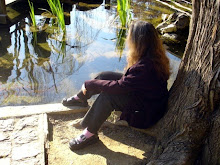

Sometime in October Paul and took a trip to the southern coasts of Washington and Oregon. We had never been that far down the coast before and figured some exploration was in order. We took the RV and spent the night in the campground at Cape Disappointment and decided to head down Hwy 101 into Oregon. Right off the highway, Paul spotted the gate to this lovely graveyard just outside of
Ilwaco and of course I wanted to stop. These two stone pillars stood like sentries on the road into the cemetery and all I could see from the highway was a rising hill edged with evergreens and other shrubs and plants. Other than the signs, there was no indication that this was a cemetery. Paul parked the RV just outside the gate and proceeded to check his e-mail while I ventured into the unknown.

The paved road leading onto the property was a bit of a steep climb and there was the constant humming of crickets. Other than that, all was very still and quiet. No birds
chattering, no wind
whispering through the drying grasses, just crickets. And when they stopped for even a moment, the sudden silence was a bit unnerving. Of course, it was also a bit odd to be walking beneath the graves themselves, which were embedded into the gently sloping hill above my head.
Many of the graves were old but still in quite good condition. It reminded me of something I read in the book "The American Resting Place: 400 years of History Through Our Cemeteries and Burying Grounds" by
Marily Yalom and Reid
Yalom. She talked at one point about how some schools use the local cemeteries to teach kids history. I thought that was a splendid idea: how else to make history meaningful and real? I wish my instructors had done that. I would have been all over it!
The memorial to the six unknown sailors memorial was really moving for me; I'm not quite sure why. And I thought the headstone for Beryl Brown was very cool. Each side had different images on it and I spent some time wondering what they meant to her in her life. I only had one visitor show up on that lonely hill, most likely a local making sure I wasn't vandalizing anything. They did a slow drive by and then left, not even stopping to talk with Paul, who was starting to wonder if I was
okay up there all alone. But I wasn't alone, not really. Not long after I headed back, with the song of crickets singing in my ears and the stillness of that place resonating within.



































 "Until the day breaks and the shadows fade away"
"Until the day breaks and the shadows fade away"











 This photo is the guardian of the section where Catholic nuns are buried. There were many, many, many headstones there. I enjoyed reading the names, though my friend Kat found the best- Dionysus. *giggle* I'll bet she loved that. This guardian statue had a harsh and piercing glare. Very stern indeed. That poor angel at her feet looks like he's hoping to avoid a caning.
This photo is the guardian of the section where Catholic nuns are buried. There were many, many, many headstones there. I enjoyed reading the names, though my friend Kat found the best- Dionysus. *giggle* I'll bet she loved that. This guardian statue had a harsh and piercing glare. Very stern indeed. That poor angel at her feet looks like he's hoping to avoid a caning. 

